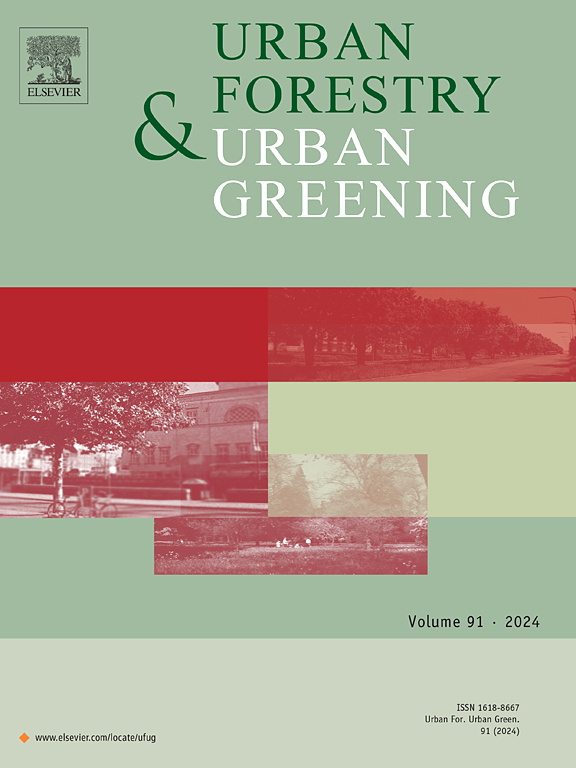理解行道树的不平等:城市布局和社会经济的相互关系
IF 6
2区 环境科学与生态学
Q1 ENVIRONMENTAL STUDIES
引用次数: 0
摘要
树木在城市生态系统中发挥着至关重要的作用,如改善空气质量、减轻气候变化影响和促进社区福祉。然而,它们在城市内的分布往往反映了社会空间差异,使一些社区对其他社区不成比例地受益。本研究考察了Pōneke新西兰惠灵顿的树木分布,特别是行道树的分布,并调查了城市布局和社会经济指标是否解释了所观察到的行道树分布和种植潜力的差异。通过对城市树木综合数据集的空间分析,探讨了街道树木分布的空间格局,并利用空间误差模型探讨了城市布局和社会经济指标对街道树木分布的影响。我们的研究结果揭示了城市地区树木覆盖率的显著空间差异。值得注意的是,只有一小部分树木(7 %)位于路边保护区,尽管有大量的路边非树木区适合额外种植(17 %)。空间误差模型表明,建筑落差、地块不规则性和道路复杂性等因素显著影响行道树分布和种植潜力,而单独的社会经济指标的解释能力有限。这些结果突出了城市设计在塑造城市绿化正义方面的关键作用,同时也说明了城市布局和社会经济因素在塑造树木分布方面的复杂相互关系。该研究表明,有针对性的街道树木种植和明智的城市规划有可能解决(街道)树木分布的差异。本文章由计算机程序翻译,如有差异,请以英文原文为准。
Understanding street tree inequities: The interrelation of urban layout and socio-economics
Trees play a crucial role in urban ecosystems, such as enhancing air quality, mitigating climate change impacts, and promoting community well-being. However, their distribution within cities often reflects socio-spatial disparities, disproportionately benefiting some neighbourhoods over others. This study examines the distribution of trees, particularly street trees, in Pōneke Wellington, Aotearoa New Zealand and investigates whether urban layout and socio-economic indicators explain the observed disparities in street tree distribution and planting potential. Using spatial analysis of a comprehensive city-wide tree dataset, we explore spatial patterns of (street) tree distribution and employ spatial error models to explore the influence of urban layout and socio-economic indicators on street tree distribution. Our findings reveal significant spatial disparities in tree coverage across the urban area. Notably, only a small fraction of trees (7 %) are located on roadside reserves, despite substantial non-treed roadside areas suitable for additional planting (17 %). The spatial error model indicates that factors such as building set-backs, parcel irregularity, and road complexity significantly influence street tree distribution and planting potential, while socio-economic indicators alone provide limited explanatory power. These results highlight the critical role of urban design in shaping urban greening justice within cities, while also illustrating the complex interrelations between urban layout and socio-economic factors in shaping tree distribution. The study suggests that targeted street tree planting and informed urban planning have potential to address observed disparities in (street) tree distribution.
求助全文
通过发布文献求助,成功后即可免费获取论文全文。
去求助
来源期刊

Urban Forestry & Urban Greening
FORESTRY-
CiteScore
11.70
自引率
12.50%
发文量
289
审稿时长
70 days
期刊介绍:
Urban Forestry and Urban Greening is a refereed, international journal aimed at presenting high-quality research with urban and peri-urban woody and non-woody vegetation and its use, planning, design, establishment and management as its main topics. Urban Forestry and Urban Greening concentrates on all tree-dominated (as joint together in the urban forest) as well as other green resources in and around urban areas, such as woodlands, public and private urban parks and gardens, urban nature areas, street tree and square plantations, botanical gardens and cemeteries.
The journal welcomes basic and applied research papers, as well as review papers and short communications. Contributions should focus on one or more of the following aspects:
-Form and functions of urban forests and other vegetation, including aspects of urban ecology.
-Policy-making, planning and design related to urban forests and other vegetation.
-Selection and establishment of tree resources and other vegetation for urban environments.
-Management of urban forests and other vegetation.
Original contributions of a high academic standard are invited from a wide range of disciplines and fields, including forestry, biology, horticulture, arboriculture, landscape ecology, pathology, soil science, hydrology, landscape architecture, landscape planning, urban planning and design, economics, sociology, environmental psychology, public health, and education.
 求助内容:
求助内容: 应助结果提醒方式:
应助结果提醒方式:


